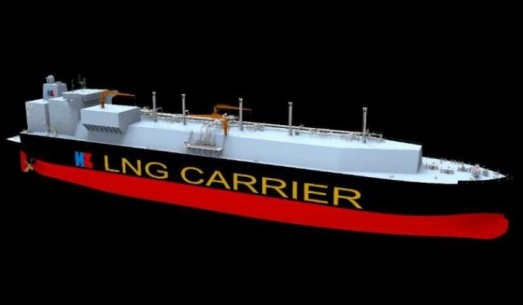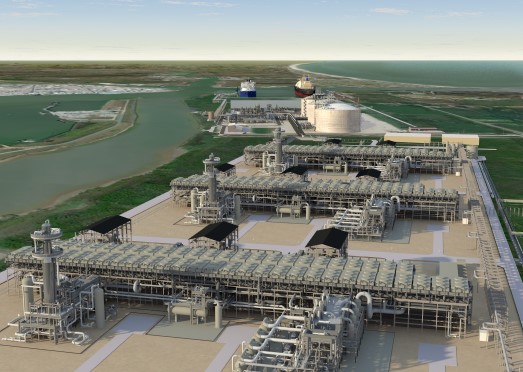^ The LNG carrier Velikiy Novgorod, ordered by Sovcomflot for Gazprom. Launched in 2014, it is the first in a series of high-tech iceclass LNG carriers that has been specially designed in accordance with Gazprom demands.
Outlook
Even before the coronavirus, the oil and gas industries were over-supplied. LNG started out 2020 with record low spot prices. Supply exceeded demand thanks to increased production from US shale oil and gas reserves, but this was mostly absorbed by the uptick in the the global economy in late 2019.
When Covid-19 entered the world stage in late January, this slight imbalance tipped over into a full-blown collapse. Oil and gas prices plummeted, cargoes were cancelled and projects were delayed and put on hold. LNG demand is estimated to be 8% lower than was projected (1).
US shale gas, which is relatively expensive to produce, will suffer the most; by contrast, countries such as Qatar will have a relatively easy time of it. As well as falling demand, factors contributing to the downturn include the need for physical distancing at workplaces and disruptions in global supply chains. Delays have been announced for projects in Canada and Australia; Russia and the USA are also likely to be affected.

The Wärtsilä 20DF engine brings fuel flexibility to dual-fuel ship engines. Photo Wärtsilä.
It is still too soon to have a clear picture of the market. In the short term demand will remain weak because of the closure of public buildings and the onset of summer in the northern hemisphere. The virus is likely to affect supply as well as demand. However, with the return of winter in the northern hemisphere and (we hope) the curbing of the coronavirus, things may return to near-normal. Asia will probably recover as early as the summer. According to Shell, LNG demand grew by 12.5% globally in 2019 (2). It could take years for this growth rate to return, but natural gas as a relative clean transition between fossil fuels and renewables is by no means out for the count.

The latest Disney Cruise Line vessels are LNG-powered. Image courtesy of Disney.
A 'necessary dinosaur'?
Nevertheless, oil and gas both attract controversy because of subsidies, which critics say would be better spent on developing renewables. Opinion is sharply divided as to whether LNG should be considered as a transition energy source or merely another fossil fuel which has seen its day. Should the EU be funding a new LNG reception terminal in Poland or a wave energy project instead? At present there is no EU country that plans to phase out all fossil-fuel subsidies. Florian Ermacora of the EU Commission’s energy directorate has admitted that natural gas is a “dinosaur”, but (she believes) one that is needed for the time being.
Markets
Most of LNG’s markets – power plants, ships, vehicles and mining – have been devastated by the Covid-19 virus.
However, power generation is still the principal market for LNG, as countries switch to gas from coal. An argument in favour of natural gas as a transition fuel is that gas pipelines could later be used to transport hydrogen. It is already possible to inject hydrogen into the gas grid. Mining has been severely affected by Covid-19, with many projects slowed or on hold. However, in the long term the industry will require more energy because the minerals have to extracted from deeper down. Pumps are required to inject water and extract the materials. A recent case is the decision by the Kirkalocka gold mine in Australia to source its energy from Evol LNG. And BHP recently decided to use LNG fuelled ships to transport its iron ore.
Which brings us to the main growth area for LNG. Whereas on land LNG competes with electricity, hydrogen, biofuels and PNG as an alternative to petroleum, when it comes to ships, LNG is unrivalled as a successor to diesel. Although construction of LNG-fuelled has slowed because of the Covid-19 virus, the upward trend in dual-fuel ships, alternating between marine diesel and LNG, is likely to continue.

Train 1 of the Cameron LNG liquefaction facility at Hackberry, Louisiana. Photo: McDermott.
Retrofitting existing ships to run on LNG is a non-starter, as the LNG takes up more space, and a special type of engine is required. Therefore, the market for new ships is likely to remain buoyant. In January SHI delivered to Teekay the first of four shuttle tankers that run on LNG as primary fuel and a mixture of LNG and recovered volatile organic compounds (VOCs) as secondary fuel. Ferries, oil carriers, chemical tankers and freight vessels are increasingly turning to dual fuel systems as an energy source. From 2016, LNG-powered cruise ships have been developed by Carnival and Disney Cruise Line.
LNG carriers

The LNG glut, intensified by Covid-19, is slowing LNG sea transport. Cargoes are being cancelled, rescheduled and rerouted.
Russia is exploiting its geographical position to develop icebreakers that can transport LNG across the Arctic.
A pilot gas carrier vessel for the Arctic LNG 2 project will be built to cope with the Arctic conditions; it will be able to ram ice up to 2.1 metres thick. Virtually all the carriers being built follow the dual-fuel design and can run on diesel alternating with boil-off gas.
This is true of the new carrier to be built for Total by SHI. Meanwhile a record will be set with a carrier being developed by Hudong-Zhonghua Shipyard with DNV: at 270,000 cbm it will be the largest in the world.
Other vessels
In addition to the large number of carriers being built, we may note a trend away from land towards sea: ship-to-ship bunkering, FLNGs and FSRUs make LNG transport and processing more efficient and safer. We may now add an LNG floating power plant: Kawasaki Heavy Industries is building this combined cycle plant as a mobile, distributed plant that can be used as a peak power source or in tandem with renewable power.
Export

The project information that follows is up to date at the time of writing (25 May), but the facts may change as events unfold.
The USA has become a major exporter. Last year alone saw the commissioning of two trains each at Freeport in Texas and Cameron in Louisiana. Also, Exxon Mobil and Qatar Petroleum announced the start of construction on a plant on the Gulf coast; financing of the Plaquemines LNG plant was announced in July;
Baker Hughes is testing a new facility at Calcasieu, Louisiana; Matrix will build a plant in Robeson County, North Carolina; Qatar Petroleum and ExxonMobil made the final investment for Sabine Pass, Texas; and a heads of agreement was signed for a facility at Qilak, Alaska.
Central America and the Caribbean also saw a degree of activity. The AES LNG hub in Panama started operations, McDermott has won an award to build a plant to liquefy gas from the Vaca Muerta shale field in Argentina, though the virus has cast doubt on the entire project; and a facility is being constructed at the Brazilian port of Açu. Australia has seen a number of LNG plant completions in recent years and is continuing to develop its offshore reserves to supply these plants. Notably, McDermott has been asked to provide infrastructure for the Equus project, which includes a liquefaction plant.
In Africa, contracts have been awarded for Mauritania and Senegal’s Greater Tortue FLNG and South Africa’s first LNG plant, which will also produce liquid helium. Final investment decisions were made on expanding Eni’s plant in Nigeria and Anadarko’s Mozambique Area 1 LNG project. In Asia, Malaysia has been especially active, thanks to national company Petronas. With PFLNG DUA, it has now constructed its second FLNG.
In Russia Novatek’s Arctic LNG 2 project will see three LNG trains constructed by TechnipFMC. Gazprom has renewed its plans for Baltic LNG project, which will be located at Ust-Luga Port and will involve international partners. However, the virus is especially severe in Russia and projects are likely to be slowed down.
Import
The main import markets are Europe and Asia. In Europe, new terminals have been proposed for Greece, Cyprus, Poland, Croatia and Ireland.
In China, LNG imports, which had been increasingly at a phenomenal rate, have been cut and relations with suppliers suspended. At Tangshan, phase 1 is already operational, and two more are to follow. Russia’s Novatek is building one terminal each in Japan and Vietnam, and the Tokyo Gas company is building a plant for the Philippines.
Materials
The cryogenic conditions of LNG liquefaction, transport, storage and revaporisation require materials which can withstand low temperatures and temperature fluctuations; in other words, they need to be ductile. Nickel alloys, austenitics, 9% nickel steel and aluminium (for onboard storage tanks) have all been specified. Stainless steel is used in the much sought-after Mark III membrane containment system of the cryogenic LNG tanks produced by GTT, which will feature on the giant carriers being built by Hudong-Zhonghua Shipbuilding. The primary membrane is made of corrugated stainless steel 304L, 1.2mm thick.
One material that has made quite a splash recently is a high-manganese steel (HMS) developed by Posco. In December 2018 the International Maritime Organization’s (IMO) approved it for use in cryogenic LNG storage and fuel tanks on LNG carriers and LNG-fuelled vessels. It could also be used in land storage tanks. It can replace nickel-alloy steels at a fraction of the cost and is easier to weld. The material contains 22.5% to 25.5% of manganese and can withstand temperatures as low as -196 °C. The material has been awarded Korean Standard certification.

The LNG carrier Grand Aniva, operated by Sovcomflot, dates from 2008.
It has four Moss-type spherical tanks and a capacity of 145,000 cbm.
About this Featured Story
This Featured Story is an abstract of the 4 page Featured Story in our Stainless Steel Magazine. To read the full Featured Story and many more articles, subscribe to our print magazine.
“Every two weeks we share a new Featured Story with our Stainless Steel community. Here you can find here the online abstract, and you can access the full story in our print magazine. Join us and let’s share your Featured Story on Stainless Steel World online and in print.”
– FEATURED STORY BY BRITTANI SCHROEDER
References
All images were taken before the COVID-19 pandemic, or in compliance with social distancing.
Read the full article.


